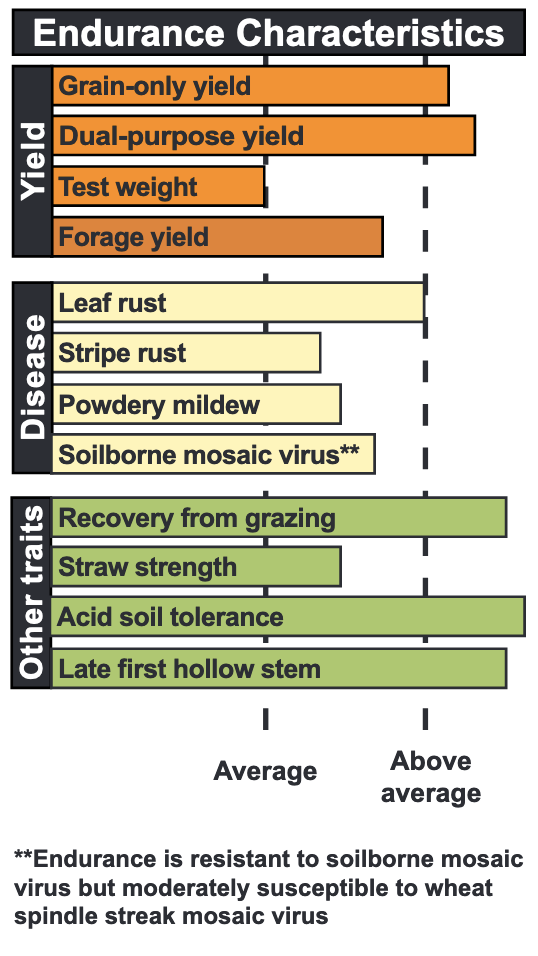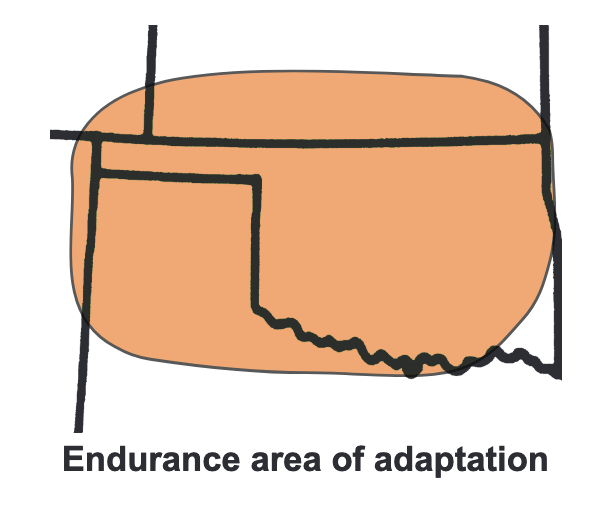Endurance
History
Endurance was released by the Oklahoma State University Wheat Improvement Team in 2004 to serve the unique needs of dual-purpose wheat producers. Experimentally tested as OK94P549-11, its pedigree is a Pioneer breeding line including TAM 105, Siouxland, and 2180. Endurance is PVP protected and can only be sold as a certified class of seed.
Yield Potential
Endurance has performed well in dual-purpose and grain-only systems throughout the state of Oklahoma (Table 1). Since Endurance is a late-maturing variety, it benefits from moderate temperatures during May. Years of yield data, however, indicate that Endurance has ability to maintain good yield potential in stressed environments as well. Test weight of Endurance is average.
Table 1. Two-year average yield (bu/ac) for Oklahoma variety trials in 2008 & 2009
| Variety | Elk City (Grain-only) | Buffalo (Grain-only) | Lahoma (Grain-only) | Marshall (Grain-only) | Marshall (Dual-purpose) | El Reno (Dual-purpose) | Cherokee (Dual-purpose) |
|---|---|---|---|---|---|---|---|
| Endurance | 28 | 69 | 64 | 46 | 34 | 58 | 51 |
| Jagger | 23 | 52 | 49 | 27 | 31 | 40 | 43 |
| Doans | 26 | 62 | 63 | 43 | 32 | 51 | 46 |
| Duster | 25 | 67 | 62 | 48 | 36 | 62 | 50 |
Unique Traits
Acid soil tolerance is one of Endurance’s  greatest strengths, and Endurance is one of the most tolerant varieties currently
available to farmers. Even though Endurance tolerates low soil pH well, growers are
still advised to lime according to soil-test recommendations.
greatest strengths, and Endurance is one of the most tolerant varieties currently
available to farmers. Even though Endurance tolerates low soil pH well, growers are
still advised to lime according to soil-test recommendations.
Endurance reaches first hollow stem as much as two weeks later than Jagger,
which allows for an extended grazing window in the spring. This trait combined with
very good regrowth following grazing makes Endurance a very good dual-purpose wheat
variety.
Endurance is tolerant to very tolerant to low pH conditions and has intermediate to moderately good straw strength.
Endurance is a moderately tall semidwarf averaging 34 inches. The variety reaches heading at the same time as Ok102 and 2174 (approximately two days later than Ok101 and three days later than Jagger). It has intermediate or slightly below average test weight.
Disease Package
Endurance is moderately resistant to leaf rust and stem rust as an adult plant and has intermediate resistance to stripe rust and fusarium head blight. Endurance is moderately susceptible to septoria and tan spot and susceptible to powdery mildew. Yield data from fungicide-treated plots at Lahoma and Apache, OK show that yield of Endurance can be improved with the use of foliar fungicides in years with moderate to heavy disease pressure.
Management
Endurance is a moderately tall variety with good straw strength.  So, lodging is possible with Endurance but not likely if fertility and planting density
are managed properly.
So, lodging is possible with Endurance but not likely if fertility and planting density
are managed properly.
As mentioned previously, Endurance is a late to first hollow stem variety. While this trait extends the grazing window in the spring, it does not mean that Endurance is more tolerant of grazing past first hollow stem than other varieties. Growers should still monitor first hollow stem in fields of Endurance and manage accordingly.
Endurance has a wide area of adaptation and is a good fit for dual-purpose and grain-only
systems in Oklahoma and surrounding areas. The later maturity of Endurance is a good
way to balance out acreage of early-maturing varieties and hedge against spring freeze
injury. Planting a later-maturity variety will not make producers immune to spring
freeze injury, but if a late spring freeze occurs, damage in later-maturing varieties
is frequently less than in earlier-maturing varieties.
